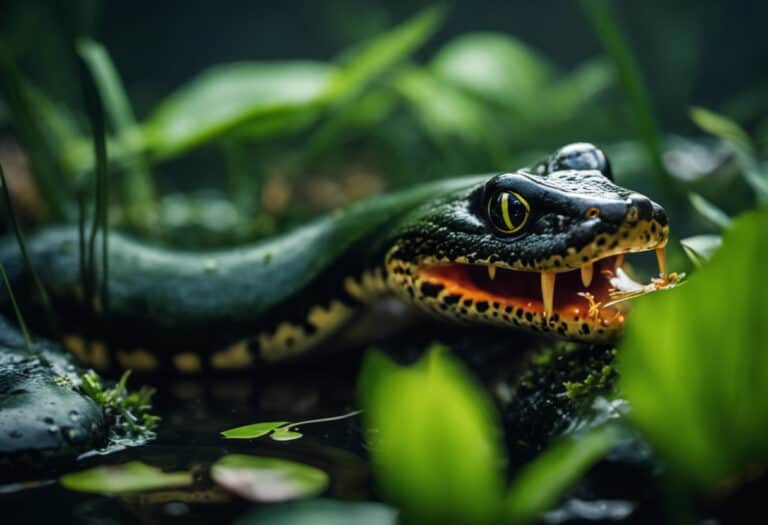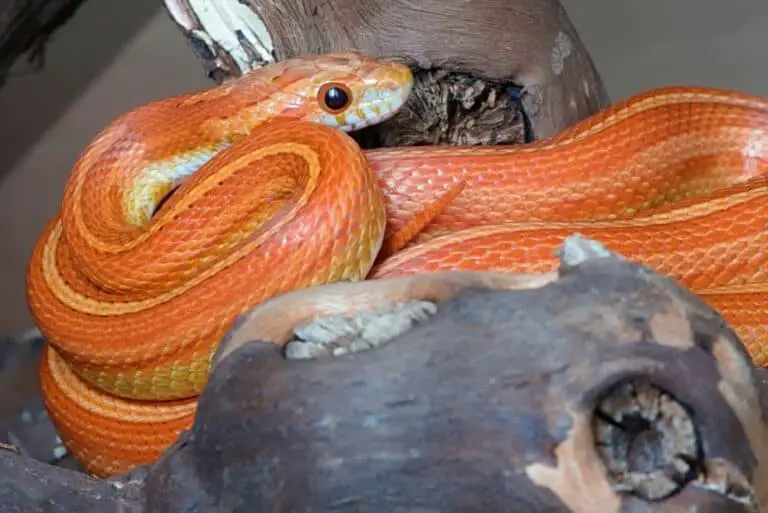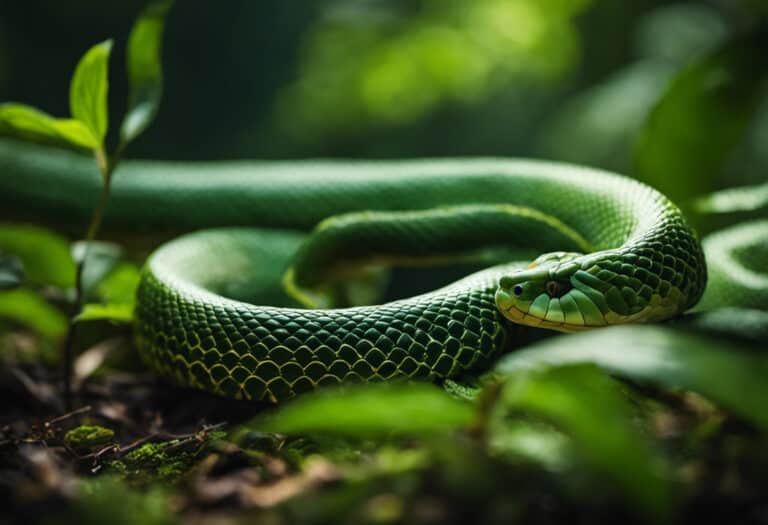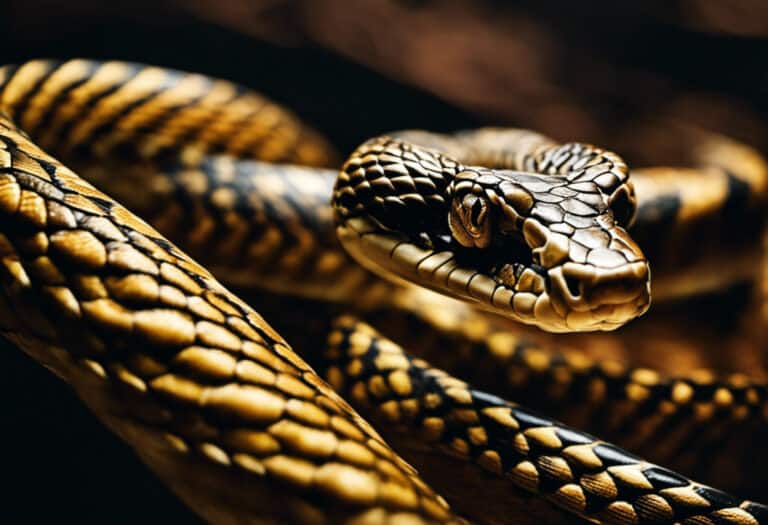How Fast Can Snakes Move?
Do you ever wonder just how fast snakes can slither? Prepare to be amazed as we dive into the captivating world of snake speed and locomotion.
From the slowest to the speediest serpents, we’ll uncover the secrets behind their remarkable agility. You’ll be surprised by the variety of speeds among different snake species, from slithering to sidewinding and even swimming.
Get ready to explore the fascinating anatomy of snakes and how it contributes to their lightning-fast movement.
Discover the thrilling truth about snake speed and unleash your curiosity.
Key Takeaways
- The speed of a snake depends on its breed, size, and environment.
- The Rosy Boa is one of the slowest snake breeds, reaching a speed of only 1.5 Km/h.
- The Sidewinder snake is considered the fastest snake, capable of slithering at speeds of up to 18 miles per hour (29 Km/h).
- Snakes generally move slowly to conserve energy and stay unnoticed, but they can move quickly when startled or hunting.
The Speed of Different Snake Species
The speed of different snake species varies depending on their breed, size, and environment. Snakes have adapted to move efficiently in their respective habitats, whether it be on land, in water, or up trees.
Some snake species, like the black mamba and the king cobra, are known for their impressive speed on land, reaching speeds of up to 12.5 miles per hour. However, it’s important to note that larger snakes tend to be slower compared to their smaller counterparts.
Additionally, the type of environment in which a snake resides can also impact its speed. Snakes in open habitats, for example, tend to be faster than those in dense vegetation.
Understanding the relationship between snake size, habitat, and speed is crucial for conservation efforts and managing snake populations in different environments.
Factors Affecting Snake Speed
You may be interested to know that factors such as size, habitat, and prey type can impact a snake’s speed.
Here are some key factors that affect snake speed:
- Size: Larger snakes tend to be slower than smaller ones due to their increased body mass and weight.
- Habitat: Snakes in open habitats, such as grasslands or deserts, have more space to move and can be faster than those in dense vegetation or confined spaces.
- Prey Type: Snakes that hunt fast-moving prey, like birds or rodents, have evolved to be faster themselves in order to catch their agile targets.
- Environmental Conditions: Temperature plays a role in snake speed, as warmer temperatures increase their metabolism and ability to move quickly.
Understanding these factors is crucial in comprehending the diverse speeds of snakes in different environments.
Snake Locomotion: Types and Techniques
Did you know that snakes have various types of locomotion techniques that allow them to move in unique ways? Snake locomotion is a fascinating topic that highlights the adaptations and efficiency of these incredible creatures.
The different types of snake locomotion include serpentine locomotion, sidewinding, concertina locomotion, rectilinear locomotion, and lateral undulation. Each technique has evolved to suit specific environments and survival strategies.
Serpentine locomotion is the most common form, where snakes propel themselves forward by flexing their bodies in a wave-like motion. Sidewinding is used by desert-dwelling snakes to navigate loose sand and hot surfaces.
Concertina locomotion is employed by arboreal snakes to climb trees, involving gripping and releasing movements. Rectilinear locomotion is a slow and deliberate movement used by larger snakes to navigate through narrow spaces. Lastly, lateral undulation is the classic slithering motion seen in most snakes.
These locomotion techniques allow snakes to move efficiently and effectively in their environments, giving them an evolutionary advantage.
The adaptations in their muscle structure, bone composition, and scale arrangement contribute to their agility and speed. Understanding snake locomotion not only provides insights into their fascinating biology but also aids in conservation efforts and habitat management.
Snake Anatomy and Its Role in Speed
With their long, slender bodies and scales reducing friction, snakes’ anatomy allows for efficient and swift movement. The role of muscle coordination in snake locomotion is crucial in achieving their impressive speed. Here are four key points to consider:
- Muscles: Snakes have an incredible 15,000 muscles, enabling precise control and coordination of their movements. These muscles work together to propel the snake forward, allowing for the smooth and seamless undulating motion.
- Bones: The bones in a snake’s body provide structure, strength, and flexibility. They serve as an anchor for the muscles, allowing for efficient transmission of force during locomotion.
- Scales: The scales covering a snake’s body not only provide protection but also assist in reducing friction while moving. This allows the snake to glide effortlessly across various surfaces, further enhancing its speed.
- Size and Shape: The size and shape of a snake can affect its speed. Larger snakes tend to be slower due to their increased mass, while smaller snakes can move more swiftly. Additionally, the elongated and flexible body shape of snakes enables them to maneuver through narrow spaces with ease.
Understanding the intricate relationship between snake anatomy and muscle coordination is crucial in comprehending their remarkable speed and agility.
The Importance of Speed for Snakes
Snakes’ speed is crucial for their survival, allowing them to catch prey and evade predators effectively. The evolution of snake speed has played a significant role in shaping their hunting strategies.
Snakes have adapted to their environments, developing different locomotion techniques to maximize their speed. Let’s take a look at how snake speed impacts their hunting strategies:
| Snake Species | Hunting Strategy | Speed |
|---|---|---|
| Black Mamba | Pursuit and ambush | Up to 12.5 mph |
| Sidewinder | Ambush and sidewinding | Up to 18 mph |
| Rat Snake | Quick strike and constrict | Varies |
| Diamondback Rattlesnake | Quick strike and venom injection | Varies |
The speed of a snake determines its ability to catch agile prey and escape from potential threats. Fast-moving snakes like the Black Mamba and Sidewinder have evolved to be swift hunters, using their speed to surprise and capture their prey.
On the other hand, snakes with a quick strike, such as the Rat Snake and Diamondback Rattlesnake, rely on their speed to effectively inject venom into their prey.
Understanding the importance of snake speed helps us appreciate their remarkable hunting strategies and highlights the need for conservation efforts to protect these fascinating creatures.
Debunking Misconceptions About Snake Speed
You may have heard misconceptions about snake speed, but it’s important to understand that snakes generally move at a slower pace unless they’re distressed or hunting. Let’s debunk some myths and learn about the evolutionary adaptations that affect snake speed:
- Snakes have evolved to move at a pace that conserves energy and helps them stay unnoticed.
- Different snake species have varying slithering speeds, with some being faster than others.
- Factors such as habitat, prey type, and temperature can influence a snake’s speed.
- Snakes have unique forms of locomotion, including rectilinear movement, sidewinding, and concertina movement.
Understanding snake speed is crucial for conservation efforts and habitat management. It allows us to appreciate the adaptations that enable snakes to catch prey and avoid predators. So remember, while some snakes can strike at high speeds, they typically slither slowly, and outrunning them is possible if maintaining a good pace.
Comparing Snake Speed to Human Speed
When it comes to comparing snake speed to human speed, there are a few key factors to consider. While certain snake species can move quickly in short bursts, humans have the advantage of sustained speed and endurance.
Additionally, factors such as terrain, environmental conditions, and individual fitness levels can play a role in determining the outcome of a race between a snake and a human.
Snake Vs Human Speed
If you were to compare the speed of a snake to that of a human, you’d find that most snakes can move faster in short bursts. Here are some interesting facts about snake speed and their abilities in different environments:
- Snakes that swim are likely faster than humans.
- Some snakes prefer to be in the water at all times.
- Not all snakes are adept at swimming.
- Snakes generally move slowly to conserve energy and stay unnoticed.
When it comes to swimming, the yellow-bellied sea snake can reach speeds of up to 1m/sec in short bursts. However, snake speed varies among different species. While some snakes can swim quickly, others may struggle in water.
It’s important to note that snakes generally move slowly to conserve energy and remain undetected in their surroundings. So, in short bursts, snakes are faster than humans, especially when it comes to swimming abilities.
Factors Affecting Snake Speed
The size of a snake can impact how quickly it can slither. There are several factors that influence snake speed, including their size, breed, and environment. To understand the relationship between snake size and speed, let’s explore the table below:
| Snake Size | Speed |
|---|---|
| Small | Faster |
| Medium | Moderate Speed |
| Large | Slower |
| Extra Large | Slowest |
As we can see, smaller snakes tend to be faster, while larger snakes are generally slower. This is because smaller snakes have a lighter body and less mass to move, allowing them to slither more quickly.
On the other hand, larger snakes have more weight to carry, which can slow down their movements. Additionally, the breed and environment of a snake can also affect its speed. Some breeds are naturally faster than others, and snakes in open habitats may be faster than those in dense vegetation.
Overall, the size of a snake is just one of the many factors that contribute to its speed.
Importance of Snake Speed
Understanding the importance of snake speed can provide valuable insights into their hunting abilities and survival strategies. Snakes have adapted to different environments, and their speed plays a crucial role in their hunting strategies. Here are some key points to consider:
- Snake speed varies in different environments, with some snakes being faster on land and others in water.
- Snakes use their speed to effectively capture prey, especially agile animals like birds and small mammals.
- Fast-moving snakes have an advantage in escaping from predators and dangerous situations.
- Snake speed is influenced by their hunting strategies, such as ambush predators relying on quick strikes while active hunters chase down their prey.
Can Humans Outrun Snakes?
Can humans outrun snakes? Well, it depends on the species and the circumstances. While snakes can reach impressive speeds in short bursts, they generally move slowly throughout the day.
With an average jogging speed of eight miles per hour, it’s possible for humans to outrun most snakes if they maintain a good pace.
However, it’s important to remember that snakes have other ways to catch their prey, such as their striking ability, so it’s always best to avoid confrontation with these fascinating creatures.
Human Vs Snake Speed
You may be surprised to learn that the average human jogger moves at eight miles per hour, while the fastest snakes can reach speeds of 12-18 miles per hour. When it comes to swimming abilities, snakes have the advantage over humans.
Here are some interesting facts about snake speed and swimming abilities:
- Snakes that swim are likely faster than humans.
- Not all snakes are adept at swimming.
- Snakes generally move slowly to conserve energy and stay unnoticed.
- The fastest snake, the black mamba, can reach speeds of 20 km/h.
In different environments, snakes exhibit varying speeds. The speed of a snake depends on its breed, size, and environment.
Snakes in open habitats tend to be faster than those in dense vegetation. Additionally, the type of prey a snake hunts can influence its speed, with snakes that chase fast prey being faster themselves.
Understanding snake speed and swimming abilities is crucial for conserving these fascinating creatures and managing their habitats.
Factors Affecting Snake Speed
When considering factors that affect snake speed, it’s important to take into account the snake’s breed, size, and environment. These factors play a significant role in determining the agility and speed of a snake.
The relationship between snake size and speed is an interesting one. Generally, larger snakes tend to be slower compared to their smaller counterparts. This is because larger snakes have more mass to move, which requires more energy and coordination.
Additionally, the environment in which a snake resides also influences its speed. Snakes in open habitats, such as grasslands or deserts, may have evolved to be faster to catch agile prey or escape from predators.
Furthermore, the type of prey a snake hunts can also affect its speed, with snakes that chase fast prey being faster themselves.
Overall, these factors contribute to the varying speeds and agility observed among snake species.
Frequently Asked Questions
What Is the Average Speed of a Snake?
The average speed of a snake varies depending on factors such as species, size, and environment. Different snake species can have different speeds, ranging from slow to fast.
How Do Factors Like Size and Habitat Affect a Snake’s Speed?
Factors like size and habitat affect a snake’s speed. Larger snakes are generally slower, while those in open habitats tend to be faster. Temperature can also influence their speed, as warmer temperatures increase metabolism. Predators play a role as well.
What Are the Different Types of Snake Locomotion and How Do They Contribute to Speed?
Snake locomotion consists of slithering and sidewinding. Slithering is the most common and efficient form, allowing snakes to move smoothly. Temperature affects snake speed by increasing their metabolism, enabling faster movement.
How Does Snake Anatomy Play a Role in Their Ability to Move Quickly?
The snake’s musculature allows it to move quickly, with 15,000 muscles providing flexibility and strength. Its long, slender body shape reduces friction and enables efficient movement through narrow spaces.
Why Is Speed Important for Snakes in Their Natural Environment?
Speed is crucial for snakes in their natural environment. It provides predatory advantages, allowing them to catch agile prey and escape from predators. Understanding snake speed aids conservation efforts and habitat management.
Conclusion
So now you know the truth about snake speed. These slithering creatures aren’t to be underestimated. From the lightning-fast movements of the black mamba to the graceful swimming of the sea snake, snakes have evolved incredible ways to navigate their world.
Their unique anatomy and specialized techniques allow them to swiftly capture prey, evade danger, and explore with efficiency.
Next time you encounter a snake, remember to appreciate their remarkable speed and agility. Just be glad that you, as a human, have other talents, because outrunning a snake? Well, that’s a race you’re not likely to win.






